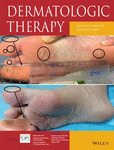Rapid remission of Stevens–Johnson syndrome by combination therapy using etanercept and intravenous immunoglobulin and a review of the literature
Abstract
Stevens–Johnson syndrome/toxic epidermal necrolysis (SJS/TEN) are spectrum of rare, acute, and life-threatening delayed-type drug hypersensitivity reactions that are associated with high mortality rates. However, no therapeutic standard has been proposed for SJS/TEN. Here, we report a case of a patient diagnosed with Stevens–Johnson syndrome whose disease progression was halted by a single dose of etanercept and was treated successfully. In addition, we reviewed the literature reporting patients with SJS/TEN treated with similar regimens.
CONFLICT OF INTEREST
None reported.




